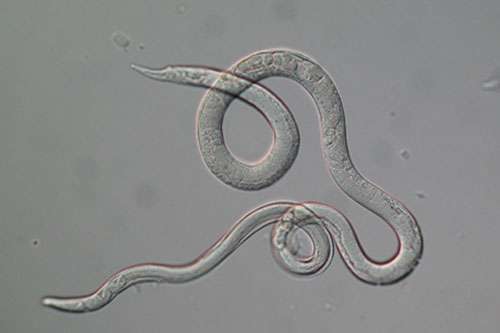Exploring the genomic basis of parasitism

The genes that cause parasitism in a group of intestinal worms, responsible for one of most prevalent tropical diseases in the developing world, have been identified by an international team of scientists, led by the University of Bristol.
More than a billion people are infected with intestinal worms (nematodes). These infections can impair physical and educational development, with the World Health Organization estimating that worldwide they cause an annual disease burden of 5 million Years Lost due to Disability (YLD), greater than that for malaria (4 million YLD) and HIV/AIDS (4.5 million).
Professor Mark Viney of Bristol's School of Biological Sciences and colleagues compared the genomes of four soil-transmitted nematodes (known as Strongyloides), including the human pathogen S. stercoralis, with a free-living relative (Rhabditophanes sp).
Understanding the molecular and genetic differences between parasitic and free-living organisms is an essential step towards identifying novel drug targets and other methods of controlling parasitic worms and the diseases they cause.
The researchers found that most genes expanded in parasitic species are specifically used in the parasitic stages and are within genomic clusters, concentrated in regions of chromosome II. This is consistent with the idea that the within-host stages of parasitic nematodes deploy a specific biology that enables them to be successful parasites.
Professor Viney said: "This is the first time we've been able to find the genes that underline parasitism in these worms. That's a significant step to better understanding how they survive and thrive – which we hope will ultimately lead to new and better treatments.
"More than one fifth of the people on this planet are infected by parasitic worms so finding effective ways to treat them is important for the well-being of some of the world's most vulnerable people."
Dr Matt Berriman, senior group leader at the Wellcome Trust Sanger Institute, said: "We really want to know what makes these worms into parasites. Several related species are parasites to different degrees and comparing their genomes has shown us some key genes involved in this process. Crucially, the collaboration with the Bristol team has enabled us to look into the parasite and free-living forms of the same species and see just how important these genes appear to be."
The study is published today in Nature Genetics.
More information: Vicky L Hunt et al. The genomic basis of parasitism in the Strongyloides clade of nematodes, Nature Genetics (2016). DOI: 10.1038/ng.3495
Journal information: Nature Genetics
Provided by University of Bristol




















